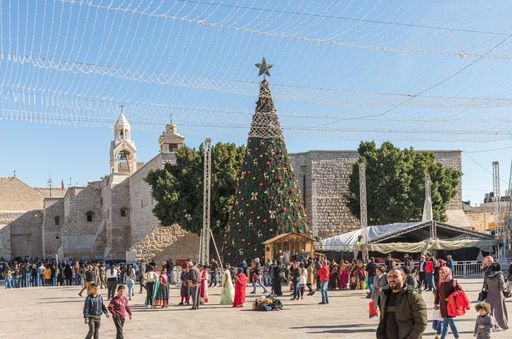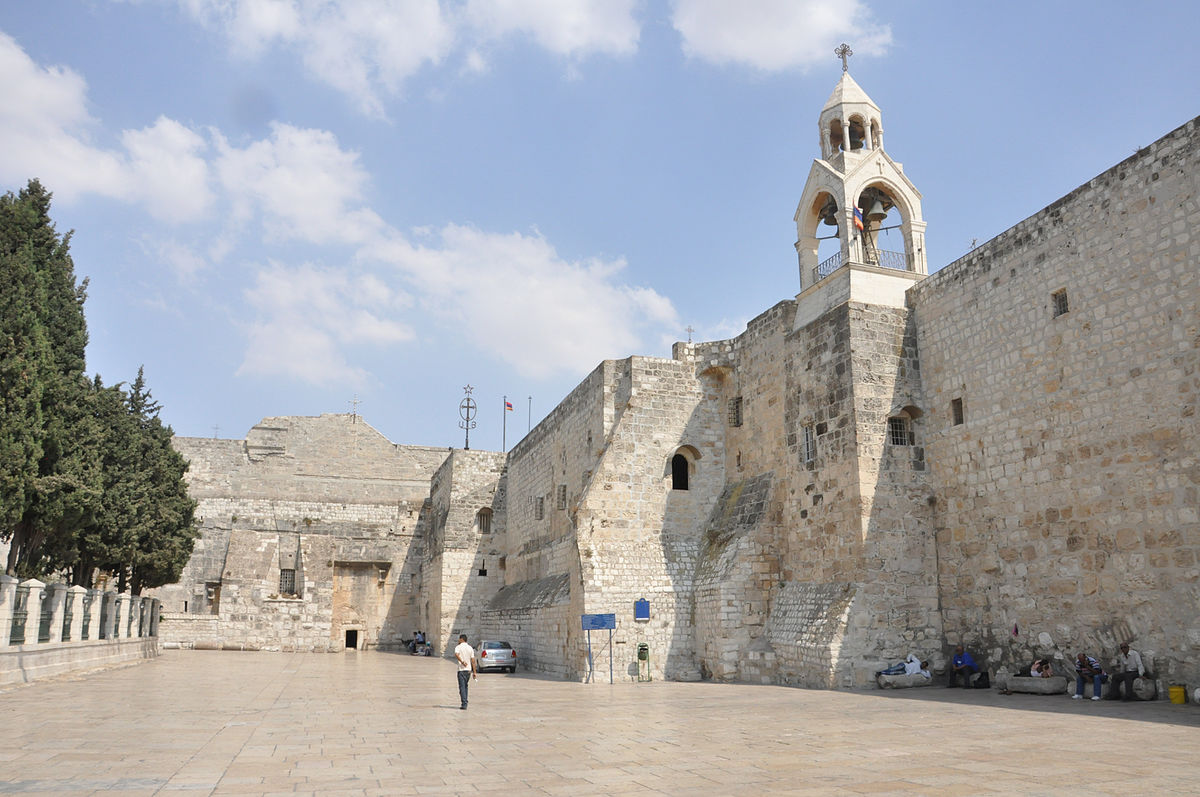
Manger Square, Betlehem
Christmas in January
Sometimes it is claimed that the Orthodox churches applies a more original tradition celebrating Christmas at Epiphany on January 6. How about that thing? This is an attempt to find out the complicated reality.
The custom of celebrating Epiphany on January 6 originated in the Orient. At first, they celebrated the baptism of Jesus. Gradually, they also came to celebrate the birth of Jesus on the same occasion.
In Rome, where there was no Epiphany feast. Instead they began to celebrate the birth of Jesus on December 25. During the fourth century, the two parties competed with each other. However, the Roman celebration spread eastwards, first to Constantinople, later in the 4th century also to the Patriarchates of Jerusalem, Antioch and Alexandria, but not to the Armenian Church. At the same time, Epiphany also began to be celebrated in the West, but later the subject of the celebration changed to the Adoration of the Wise Men.
Most of Christendom celebrates the birth of Christ on December 25. But when the Roman Church introduced the Gregorian calendar in 1582, it fell out of step with many other countries and churches. Within a few decades, the new calendar had indeed been introduced in most of southern and western Europe, but in e.g. in Great Britain it was first introduced in 1752 and in Sweden in 1753. With the lag of the old calendar, it meant that in Sweden during the early 18th century, Christmas Day was celebrated when according to the Gregorian calendar it was January 5.
In Eastern Europe and the Orient, the old calendar was retained later in time. Gradually, however, these countries also introduced the new Gregorian calendar in the civil system, while churches kept the old one, which of course brought practical problems. Therefore, the Ecumenical Patriarch of Constantinople in 1923 called together most of the Orthodox churches to discuss the issue. In March 1924, the Patriarchate of Constantinople introduced the new calendar. It was then also adopted by the Patriarchate of Alexandria and Antioch as well as by the Orthodox Churches in Greece, Cyprus, Romania and Poland. Also the Orthodox Church in Finland, which in 1923 moved from Moscow to Constantinople, thereby introduced the new calendar. However, the Patriarchate in Jerusalem and the great churches in Russia, Serbia and Bulgaria, as well as most of the monasteries on Mount Athos, continued to follow the old calendar. However, in 1968 the Bulgarian Church and in 2023 the Orthodox Church in Ukraine switched to the new calendar.
As far as Oriental churches are concerned, the Coptic Church, like the Ethiopian, has retained the old Julian calendar. Since 1955, however, the Syriac Orthodox Church celebrates Christmas and Epiphany according to the Gregorian calendar (for Easter, the Julian calendar still applies), except in the Holy Land.
The Armenian Church introduced the Gregorian calendar in 1924 but, as said, has never introduced a special Christmas celebration, but instead celebrates the birth of Christ at Epiphany. However, some parts of the church outside of Armenia were kept, i.a. the patriarchate in Jerusalem, the old calendar in such places where they did not want to deviate from the orthodox environment.
It is a widespread (mis)perception that the Orthodox churches celebrate Christmas on January 6. This misunderstanding is probably due to the fact that Christmas Day according to the old calendar during the period 1801–1900 really happened to fall on January 6. The misunderstanding was then introduced into various handbooks and propagated into the next century, although from 1901 the shift increased by one day to January 7. Since the year 2000 was a leap year, there was no further shift in the 21st century, but starting in 2101, the Julian calendar's Christmas will not fall until January 8.

Church of the Nativity
There are thus four different occasions when Christian churches celebrate the birth of Christ.
On December 25, Christmas is celebrated in the Western churches as well as in Orthodox churches in i.a. Greece, Romania, Bulgaria and Finland as well as in most of the Syrian Orthodox.
On January 6, most Armenians celebrate Epiphany.
January 7 is the time for the Russian Orthodox, the Serbs, the Syrians in the Holy Land, the Copts and the Ethiopians.
Finally, on January 19, Epiphany falls in the Armenian Patriarchate of Jerusalem.
Therefore you can celebrate Christmas in the Church of the Nativity in Bethlehem at three different occasions.
After a large procession in the Manger Square on December 24, the Latin Patriarch celebrates Midnight Mass in the Franciscan Church of St. Catherine, after which you continue down to the grotto of the Nativity under the altar of the Church of the Nativity.
On January 6, again it is Christmas Eve in Bethlehem. In the morning, first the Syrian Orthodox Archbishop, then the Coptic Archbishop and finally the Greek Orthodox Patriarch arrive at the Manger Square. During the afternoon, the various churches hold vespers in the Church of the Nativity. Meanwhile, the Ethiopian Archbishop arrives with his monks at the Ethiopian Church of Jesus. During the evening, the Syrians and the Copts each celebrate their liturgy in the Church of the Nativity. At midnight, the Greek Orthodox liturgy takes place while the Ethiopians celebrate in their own church.
Then the third celebration follows. January 18 is Christmas Eve, actually Epiphany, for the Armenians who are under the Patriarch of Jerusalem. In the morning, the Armenian patriarch arrives at the Manger Square, after which there will be vesper in the Church of the Nativity at the altar of the Holy Three Kings in the northern side choir of the Church of the Nativity, which is administered by the Armenians. During the evening and night of January 19, a service is then celebrated in the Church of the Nativity, followed by Mass in the Nativity Cave.
Anders
Brogren
Dean h.c., Falkenberg, Sweden
Sankt Lars Kyrkogata 4
S-311 31 SWEDEN
Mail
to
anders [ at ] brogren.nu